The Best Desert Trees with Pictures and Names
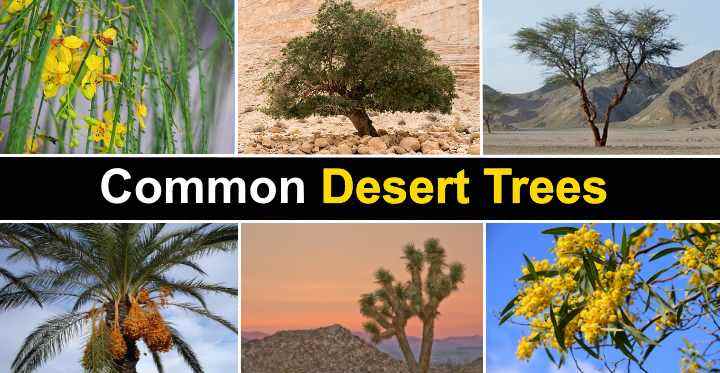
Desert trees tolerate harsh, hot, arid climates and still produce foliage and, sometimes, fruit. The desert biome is an ecosystem that typically has dry, sandy soil, and very little rainfall. Trees that grow in a desert environment need extensive root systems to absorb moisture and then store it in the trunk. If you live in a desert climate, growing suitable drought-tolerant trees in your backyard can give you needed shade from the beating sun.
What Kinds of Trees Grow in the Desert? Trees native to the desert biome include drought-resistant mesquite trees, types of acacia trees, and desert willow trees. These trees provide lush foliage and bright colors when they flower. Some other types of desert plants that thrive in hot, arid environments are the Joshua tree, ironwood tree, chaste tree, and date palm trees.
The types of trees that thrive in the desert flora should be the following:
- Trees that grow well in full sun.
- Drought-resistant trees that can hold in moisture.
- Desert trees that thrive in infertile, sandy, or rocky soil.
- Trees that can thrive in hot temperatures in the daytime and cold temperatures at night.
This article lists some of the most common and popular trees to grace desert landscape gardens. You will find fast-growing and slow-growing trees that grow in hot, dry, desert environments.
How to Care for Desert Trees
If you live in a desert climate, growing desert trees in your backyard is very easy. Desert-dwelling trees need to grow in sandy, well-draining soil, and full sun. Once established, desert landscape trees need occasional deep irrigation to keep the roots moist. In states such as Arizona, Texas, or California, you may need to water desert trees every week to ten days during the summer.
The Best Desert Trees (with Pictures and Names) – Identification Guide
Here are some of the most popular desert trees. The list below includes pictures and scientific names of trees found in the desert biome.
Desert Ironwood Tree (Olneya tesota)
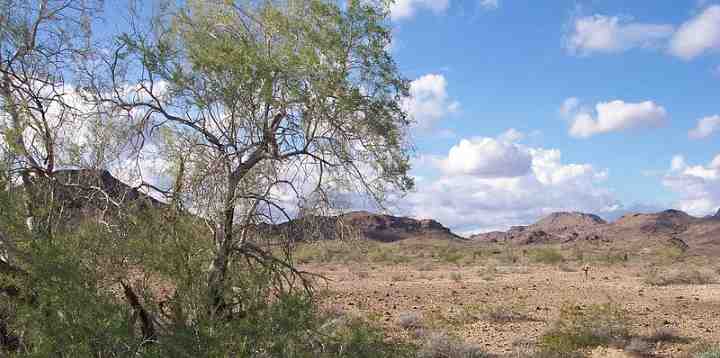
One of the most impressive small desert trees is the ironwood tree. This evergreen tree is native to the Sonoran Desert and has leaves that are a bluish-green color. With the proper pruning, you can grow the ironwood tree as a desert bush or small shade tree. In early summer, purple and red flowers brighten up this desert tree.
Other names for this desert tree are musclewood and hornbeam. These common names refer to the hardwood that the tree produces. If you live in a scorching climate, plant the desert landscape tree where it gets some shade.
Palo Verde (Parkinsonia aculeata)
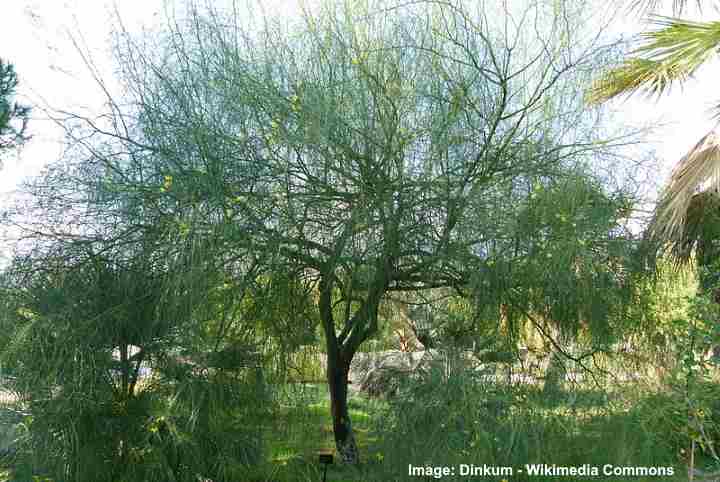
The palo verde is a stunning type of desert tree with beautiful green leaves and a multi-branch structure. When the tree flowers, it transforms into a mass of white and yellow fragrant flowers to fill your garden with color and scent. The leaves of this deciduous tree fall off in the dry season.
The palo verde tree also goes by names such as the jelly bean tree or Jerusalem thorn. This adaptable tree can withstand drought, and it grows in various environments. It’s a magnificent tree to grow in full sun where you want to provide some shade in your yard.
Sweet Acacia Tree / Acacia Farnesiana (Vachellia farnesiana)
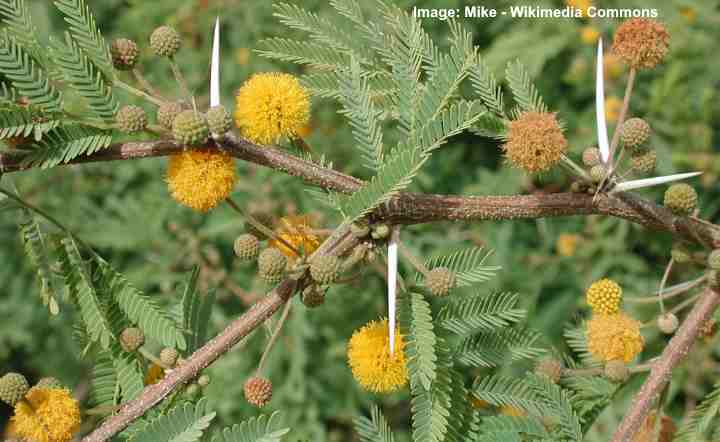
The sweet acacia tree, also named needle bush, acacia farnesiana, and prickly mimosa bush, is a medium-sized flowering tree that thrives in desert environments. This acacia tree can reach heights of between 20 and 30 ft. (6 – 9 m) and its wide spread provides plenty of shade. Depending on your climate, the tree can be messy as it is deciduous in some climates. However, in many desert areas, it’s an evergreen tree that doesn’t shed leaves.
The tree is characterized by spiky branches and yellow puffball flowers that give yards fragrance and color when they bloom.
Shoestring Acacia (Acacia stenophylla)
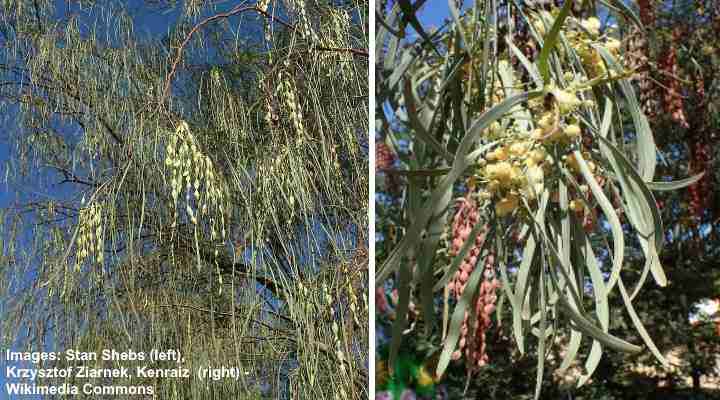
The shoestring acacia is a tall, beautiful, upright flowering desert tree that has long thin leaves that create a weeping form. This evergreen desert tree is a fast-growing tree that can grow to between 13 and 33 ft. (4 – 10 m). This plant thrives well in intense heat, and it also tolerates cool desert temperatures.
Even though this is an evergreen acacia, it can experience leaf drop in a drought. To keep your tree from becoming messy, water it regularly in the summer season.
Desert Willow (Chilopsis linearis)
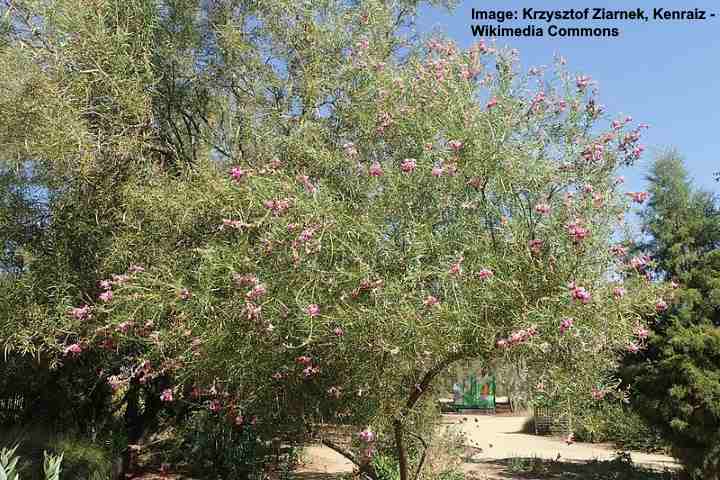
In this picture: Chilopsis linearis ‘Timeless Beauty’
If you’re looking for a small, bush-like flowering tree for shade in a desert landscape, the desert willow is an excellent choice. This type of desert tree has willow-like leaves —however, it’s not a true willow. The tree grows exceptionally well in arid climates and is drought-tolerant.
The attractive feature of this desert tree is its large, showy flowers. These trumpet-shaped blooms blossom in magenta or purple colors to add beauty and color to a barren landscape.
Catclaw Acacia (Senegalia greggii)
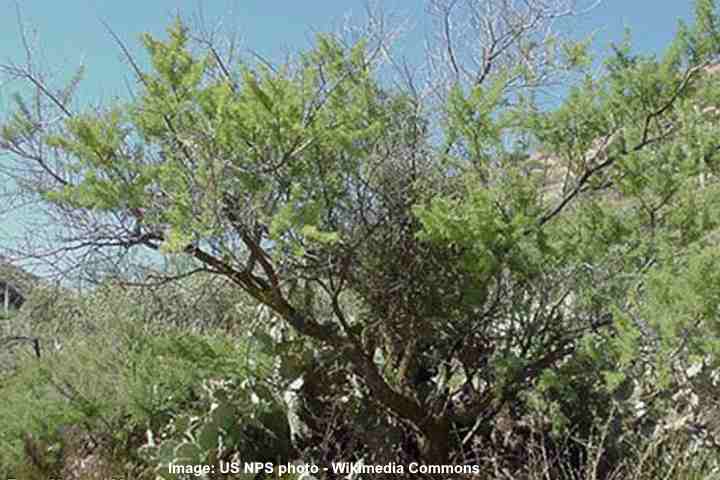
Also called the paradise flower and wait-a-minute bush, the catclaw acacia is a small tree that grows in the arid climate of the Southwest and Mexico. This small shrubby tree only grows to about 10 ft. (3 m), making it a perfect choice for small yards in a desert climate.
The common name for this type of desert tree comes from the hooked prickles on the branches. Beautiful flowers blossom in the spring, filling yards with sweet scents. Because the tree is cold hardy to 0°F (-17°C), it’s a suitable desert landscape tree for most areas.
African Sumac (Rhus lancea)
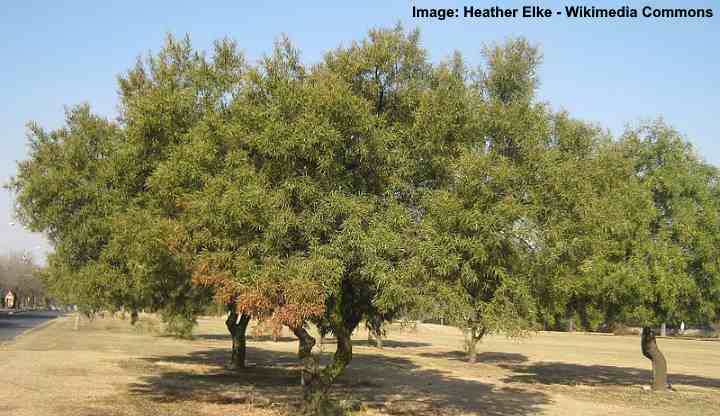
The African sumac tree is a small, bushy desert tree that is resistant to drought. This tree, native to African deserts, has a shade canopy and can be pruned to keep its size small. If you need a dense shade tree in your yard, you can let the tree reach its regular height of between 20 and 30 ft. (6 – 10 m).
The small pine-like leaves drop every year, and it can become messy. However, the fallen leaves can be collected and used as mulch in your yard. The tree flowers yearly, but the blossoms are inconspicuous.
Chaste Tree (Vitex agnus-castus)

The chaste tree (vitex) can grow in desert climates as a small bush or medium-sized tree. The large shrub is native to the Mediterranean and grows well in the Southwestern states of the U.S. Dense green foliage makes this an excellent shade tree to get protection from the summer heat.
The striking feature of the chaste tree is the blue to lavender floral spikes that blossom in the summer. Some types of this desert-loving plant have white or pink flowers.
Forman’s Eucalyptus (Eucalyptus formanii)
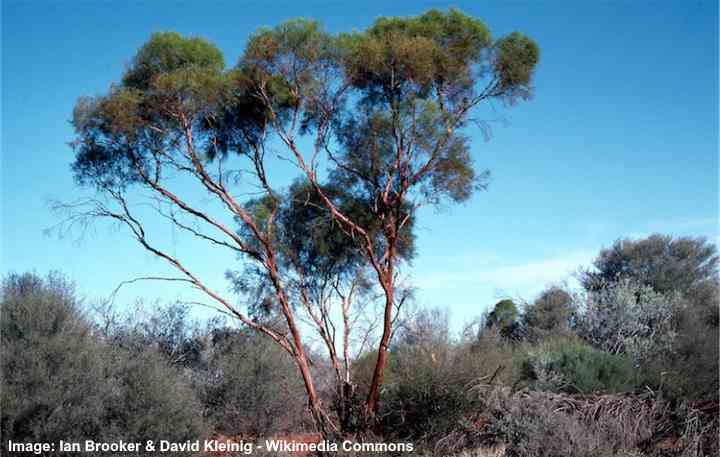
The Forman’s eucalyptus tree is one of the smallest species of eucalyptus for desert landscape gardens. The medium-sized tree usually grows to a height of 33 ft. (10 m). There is a bushy foliage crown at the end of the branches. Eucalyptus are generally fast-growing trees that survive the heat and a lack of water.
Boojum Tree (Fouquieria columnaris)
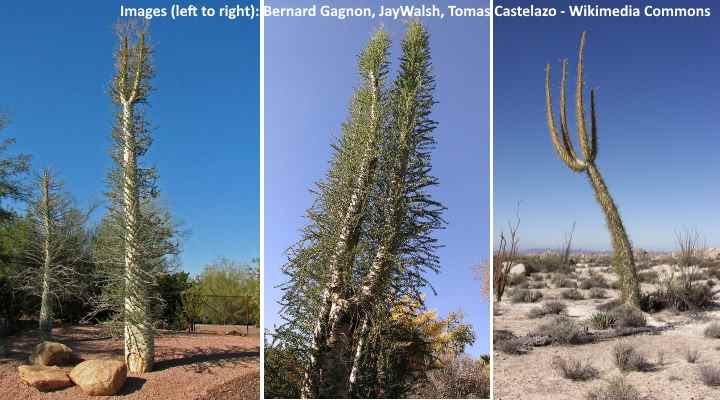
Fouquieria columnaris, – boojum tree or cirio is a tree in the ocotillo family which is found in the desert biome
The Boojum tree belongs to the ocotillo family and is one of the most unusual desert trees on this list because it looks like a giant type of cactus. This type of desert plant commonly grows in the Sonoran Desert. This tree is sometimes characterized by unusual branching and bending. Secondary branches grow at the top of the thick succulent main branch.
These unique-looking trees can grow up to 70 ft. (20 m) in the desert environment. Their creamy white flowers with honey scents blossom in the summer and fall.
Date Palm Tree (Phoenix dactylifera)
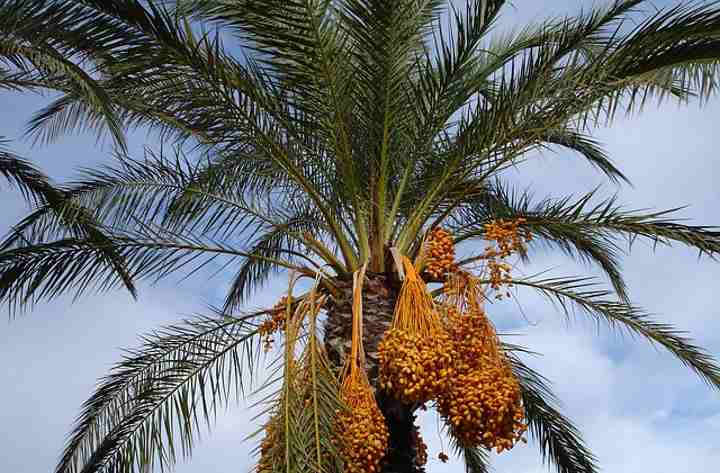
Date palm trees can grow in the desert, and they can add beauty to gardens in hot, dry climates. Not all types of date palms are suitable for deserts. So, if you’re looking for a suitable type of palm tree, choose the Phoenix dactylifera. This palm tree grows well in arid and semi-arid regions.
This variety of desert date palm can withstand extended drought and hot temperatures. The palm doesn’t survive in climates below 20°F (-6°C).
Texas Mountain Laurel (Dermatophyllum secundiflorum)
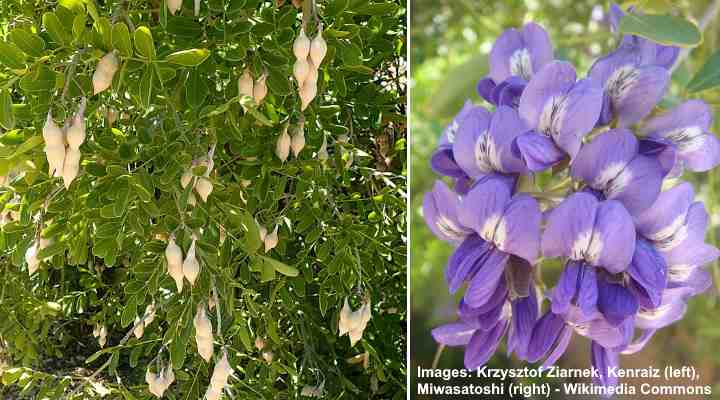
The Texas mountain laurel is a type of small desert tree that thrives in arid landscapes. Depending on how you care for this tree, you can keep it as a flowering type of shrub. The small tree is not messy due to its evergreen leaves. The slow-growing tree is native to deserts in the Southwestern U.S. and Mexico. This low-maintenance, heat-tolerant plant produces beautiful purple flowers to brighten up a spring desert garden.
The Texas mountain laurel is a desert tree that grows well in poor soil and only needs minimal watering to produce foliage and flowers. The sun-loving bushy tree seems to thrive in harsh conditions
Texas Ebony (Ebenopsis ebano)
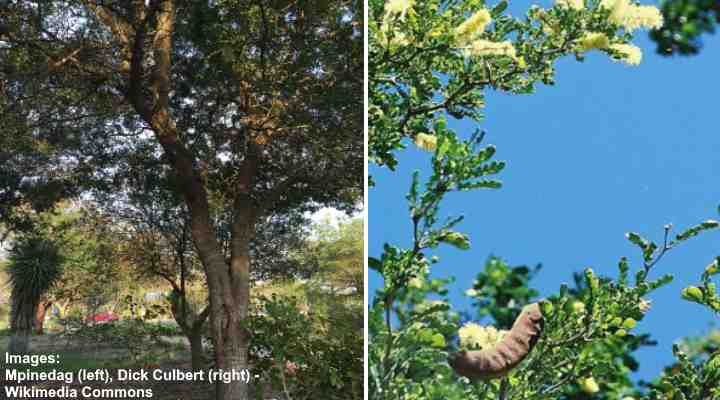
If you need a small tree with dense foliage for your desert landscape, then the Texas ebony will be sure to please. The slow-growing evergreen tree grows to around 25 ft. (7.5 m) with a spread of 6 to 15 ft. (1.8 – 4.6 m). This shrubby desert tree produces clusters of stunning puffy white fragrant flowers.
Unlike other types of desert trees, the Texas ebony produces dense foliage. So, you can plant these small desert trees together to create a privacy screen.
Sand Palm (Allagoptera Arenaria)
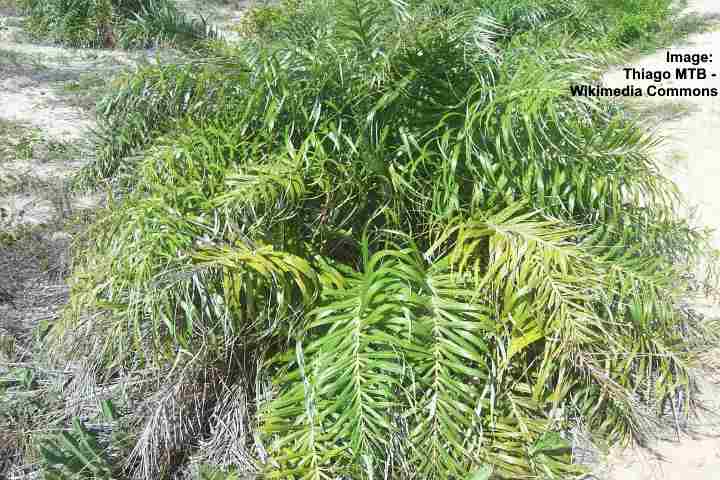
If yard space is limited, the sand palm is a type of small desert plant that is perfect for small yards. The maximum height of these sun-loving palms is about 6 ft. (1.8 m). The large feather-like leaves seem to grow straight out the ground or container. These tropical leaves grow upward and then arch over.
These palms are native to coastal regions. However, because they tolerate poor soil, drought, and heat, you can plant them in your desert garden.
Tipu (Tipuana tipu)
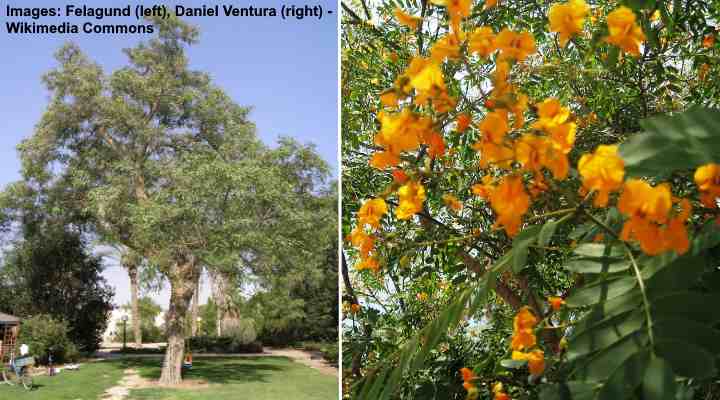
Tipu is a type of fast-growing desert shade tree with orange flowers that grows tall and wide. This huge heat-loving tree grows to around 100 ft. (30 m) tall and 65 ft. (20 m) wide—so, not a tree for small backyards. The deciduous tree can become messy when it sheds its leaves in winter and spring.
The tipu tree bursts into beautiful orange-yellow colors when it flowers for a short time in late summer.
Sissoo (Dalbergia sissoo)
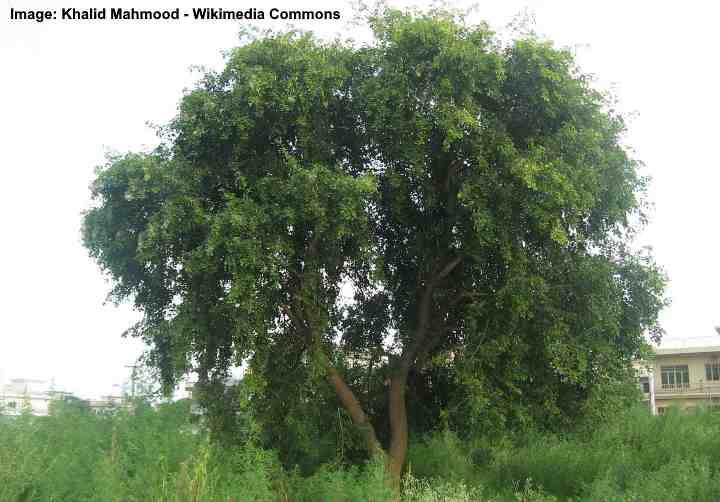
Also called the North Indian rosewood, this desert tree grows quickly in full sun and hot temperatures. The tree looks like a type of aspen, and it’s an excellent shade tree for large desert gardens. Expect this drought-resistant tree to grow up to 82 ft. (25 m). The deciduous tree has bright-green foliage with leathery leaves.
In early spring, this desert tree produces a large array of tiny pink or white flower clusters that are very fragrant. Before planting this tree in an arid garden for shade, you should be aware that it can be a messy tree, and the roots can cause damage to nearby buildings or sidewalks.
Acacia Bailey (Acacia baileyana)
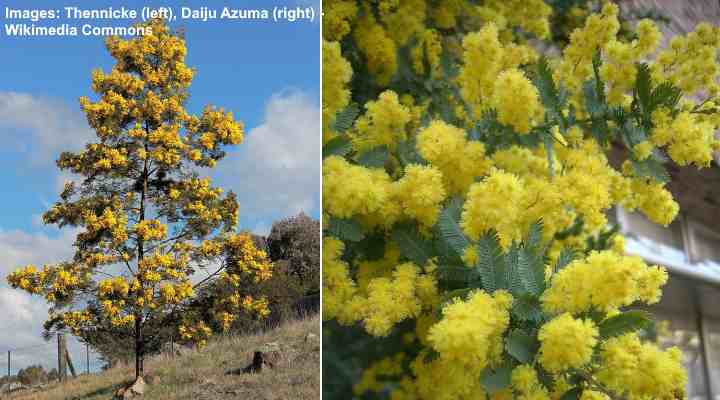
The acacia bailey tree is an ornamental desert tree that survives long periods of drought and intense heat. The feather-like foliage provides plenty of shade in desert gardens. The tree grows fast without much maintenance and can be planted in full sun and light, fertile soil.
One of the attractive features of this desert shade tree is the golden-yellow flowers that appear in early spring. These brightly-colored clusters form cylindrical shapes and have an intense fragrance.
Chilean Mesquite (Prosopis Chilensis)
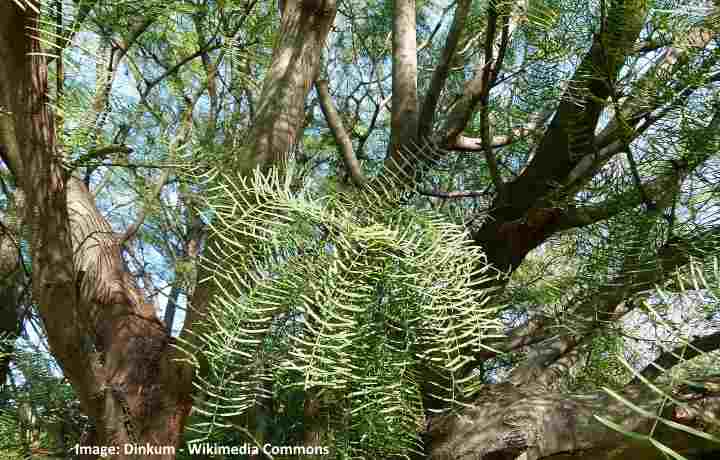
The Chilean Mesquite is one of the most common desert trees in Arizona and other Southwestern states. The popularity of this tree is its wide canopy that provides plenty of filtered shade in the desert sun. The Chilean mesquite tree has a rapid growth rate and reaches a medium size of around 46 ft. (14 m). The foliage forms long pinnate-shaped leaves, and the desert tree produces yellowish puffy flowers in early winter.
Texas Olive (Cordia boissieri)
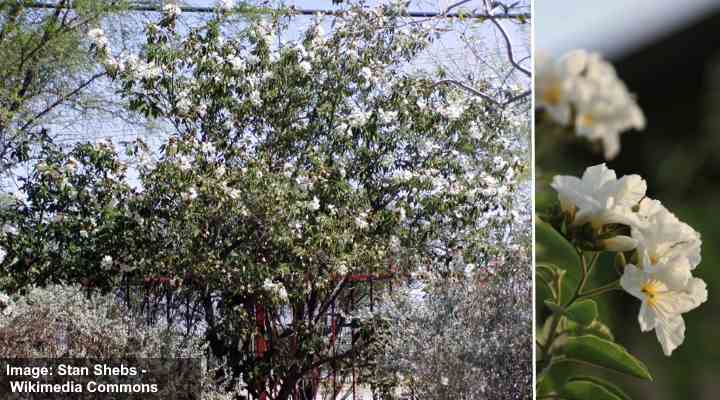
The Texas olive is a slow-growing desert tree that has large dark green leaves. The small tree is perfect for small desert gardens where you need lush green foliage. Although this tree is called an olive tree, it’s not a true type of olive tree. It is in the plant family Boraginaceae of flowering, heat-tolerant shrubs.
The small tree flowers throughout the year, and it produces blossoms of trumpet-shaped white flowers. These “olive” trees have a lifespan of 30 to 50 years.
Palo Brea (Cercidium praecox)
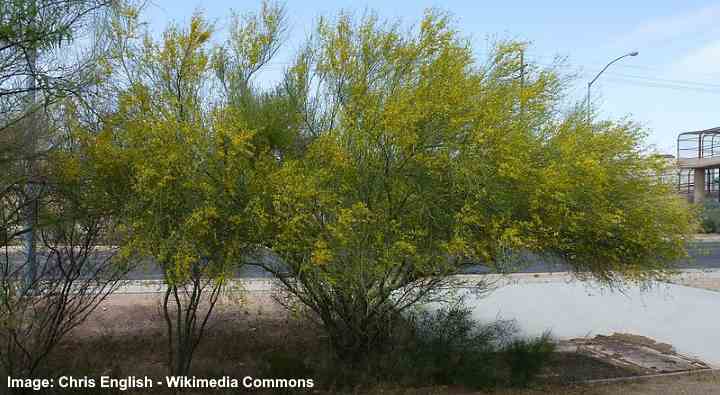
The Palo Brea is a type of desert tree that is classed as a large shrub or small tree. Depending on the growing conditions, the trees grow to between 16 and 40 ft. (5 – 12 m). This desert plant transforms into a stunning brightly-colored tree when it blooms with yellow flowers in mid-spring.
The deciduous tree only has leaves on the branches after rainfall. These grow in an umbrella shape to create shade under them. This tree is well-suited to desert environments as it is a low-water, cold-hardy tree that survives the heat and full sun exposure.
Joshua Tree (Yucca brevifolia)
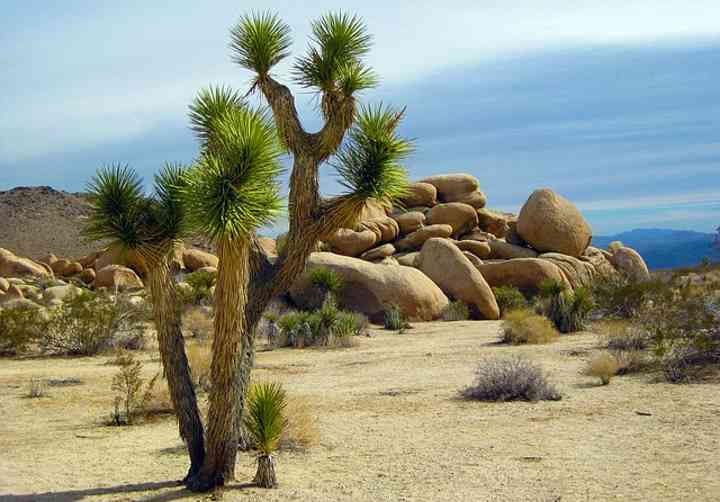
Pictures of the Joshua tree are the classic desert image of the arid landscapes in the Southwest. Although Joshua trees aren’t actually trees but a type of tree-like succulent, they are considered trees of the desert.
The Joshua tree is a type of yucca plant (the largest yucca in the world) that has thick stems and branches with green balls of spiky leaves on the ends. These desert plants are fast-growing and quickly absorb water after any rainfall.
The desert plant gets its moisture from its extensive root system that can reach down to 36 ft. (11 m) deep. The leaves of Joshua tree are evergreen, and the plant produces clusters of white desert flowers from February to late April.
Joshua trees can grow up to 70 ft. (21 meters) high, but they rarely go above 40 ft. (12 meters).
Mastic Tree (Pistacia lentiscus)

The mastic tree is one of the most popular desert trees in the Southwest due to its lush, dense foliage. This is not a messy tree because its evergreen leaves don’t drop. The tree is famed for its ability to survive in extreme heat without water for many months.
Its common name comes from the resin that is used to produce gum and as a thickening agent. The evergreen desert shrub-like tree grows up to 13 ft. (4 m) high. The tree can be used as an all-year privacy hedge. You can also plant this tree as a dwarf tree for growing in desert climates.
Related articles:
